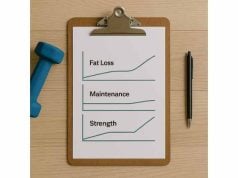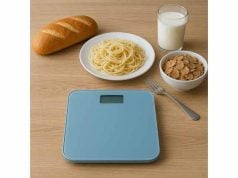
Most people chase a smaller number on the scale. Body recomposition asks a better question: are you replacing fat with muscle while your weight barely moves? The mirror, your waist, and your gym numbers often change before the scale admits it. In this guide, you will learn how to tell if recomposition is happening, which measurements actually matter, and how to judge progress in two to eight weeks without second-guessing every fluctuation. If progress has felt uneven or slow, keep our concise plateau troubleshooting guide nearby as you apply the steps below.
Table of Contents
- Body recomposition vs. scale loss explained
- How to measure recomposition week to week
- The metrics that matter
- Interpreting trends: real examples
- Common mistakes and fixes
- Special cases: hormones, medications and training status
- Your 8-week recomposition plan
- Frequently Asked Questions
Body recomposition vs. scale loss explained
Body recomposition means losing fat and gaining (or regaining) muscle at the same time. Scale loss means your total body mass is decreasing, regardless of what is changing inside that total—fat, water, and lean tissue. Both can improve health and appearance, but they feel different day to day and they demand different ways to measure progress.
What recomposition looks like in practice
- Waist and skinfolds shrink while scale weight is flat or drifts slightly.
- Clothes fit looser in the waist and tighter in shoulders or thighs.
- Gym performance improves: more reps at a given load, or higher top sets.
- Resting heart rate and recovery markers trend better with consistent sleep.
Why the scale alone misleads you
The scale rolls fat, muscle, glycogen, water, and gut contents into one number. If you start lifting seriously, increase protein, and sleep better, you can store more glycogen and water in muscle while burning fat. The scale might stall—or rise—while your body composition improves. That is not failure; it is the expected response when training quality goes up.
When to prefer scale loss
- You have a tight deadline with a weight class or medical requirement.
- You are new to tracking and need simple, fast feedback.
- You have a larger fat-loss target and want early momentum before refining.
When to target recomposition
- You are already reasonably active and can lift 2–4 days per week.
- You value body shape, performance, and health markers as much as weight.
- You have the patience to evaluate trends over a few weeks rather than days.
Rates you can expect
- Scale-focused fat loss: roughly 0.5–1.0% of body weight per week if you have more to lose; 0.25–0.75% when leaner.
- Recomposition: slower changes on the scale, but visible changes in waist (0.5–2.5 cm per month) and performance. New lifters and returning lifters see the fastest recomposition.
Before you decide which path to emphasize this month, confirm that your nutrition and movement fundamentals are in place. A quick refresher is available in our concise weight loss guide.
Key takeaway: Body recomposition favors shape, strength, and health even when weight is steady. Scale loss favors a lower number quickly. Choose the target that matches your season and measure accordingly.
How to measure recomposition week to week
Recomposition progress hides inside trends, not single readings. Use a simple, repeatable protocol for two to four weeks so you can see signal through the noise.
Daily and weekly rhythm
- Daily weigh-ins (same conditions). Weigh after waking, after the bathroom, before food or drink, on the same scale. Record each day; judge the 7-day average, not any single number. If you want structure, follow our practical daily weigh-in protocol.
- Weekly waist measurement. Measure at the navel on waking once per week. Keep the tape level, snug but not tight, and use the same spot each time.
- Weekly progress photos or a “test outfit.” Front, side, and back in similar light. Or use the same jeans and note the button tension and thigh fit.
Performance and recovery markers
- Strength log: top set load or total reps for key lifts each week (e.g., squat, hinge, press, row). Small improvements confirm muscle retention or growth.
- Step count and easy cardio: consistent movement keeps daily energy burn up and appetite steadier.
- Sleep: bedtime and wake time. Poor sleep creates water retention, raises hunger, and depresses training.
Food and protein anchors
- Protein: 0.7–1.0 g per pound of goal body weight daily, distributed across meals.
- Calories: For recomposition, start near maintenance, then use small nudges—slightly lower on rest days, slightly higher around lifting—rather than large swings.
- Logging: Track at least one component per meal (usually protein or starch) by gram weight for the first 14 days. Accuracy early keeps you from chasing noise later.
What success looks like in 2–4 weeks
- Waist: down 0.5–1.5 cm, even if weight is flat.
- Photos/clothes: visibly leaner midsection or better fit in the waist.
- Strength: 1–2 more reps at a given load, or a small load bump with good form.
- Energy: stable between meals; fewer strong cravings late at night.
Troubleshooting rule
If the 7-day weight average and waist are both flat for 3–4 weeks, verify steps, sleep, and food accuracy before changing calories. Then make one small move: reduce 100–150 calories most days or add 1,500–2,000 steps/day. Reassess in 14 days.
Key takeaway: Measure weight trend + waist + performance + visuals. Keep the routine identical so you can read trends without guessing.
The metrics that matter
You do not need a lab to measure recomposition. You need a small set of reliable metrics collected the same way every week.
Tier 1: Core metrics (use these first)
- 7-day average body weight. Smooths water and sodium swings.
- Waist circumference at the navel. Best low-tech proxy for abdominal fat.
- Strength performance. Top set load or reps on 3–5 key movements.
- Progress photos/clothes fit. Validates what numbers suggest.
Why these work: Together, they capture fat loss (waist), muscle retention or gain (strength), and the sum of changes (visuals). The scale average contextualizes the rest.
Tier 2: Helpful additions
- Thigh, hip, chest circumference. Shows where you are losing size (or building) beyond the waist.
- Resting heart rate and morning energy. Often improve with better recovery and fitness.
- Subjective appetite and satiety notes. A one-line daily note helps spot patterns that derail adherence.
Tier 3: Optional tools (use if available)
- DEXA. Useful for trend comparisons a few months apart. Daily or weekly changes are noise.
- BIA scales. Sensitive to hydration and timing; only read the trend under identical conditions.
- Skinfold calipers. Require practice and consistent technique. If you cannot repeat precisely, skip.
What to ignore (most of the time)
- Single-day weight spikes. Usually sodium, glycogen, or a later meal.
- Apps that estimate “calories burned.” Wrist-based numbers are rough. Use them to set steps, not to “eat back” calories precisely.
- Hourly weigh-ins. They produce anxiety without better decisions.
Setting thresholds that force action
- Waist: no change for 3–4 weeks in a recomposition phase → check steps, sleep, and protein; then adjust calories slightly.
- Strength: decline across two weeks → lower training volume or add rest; consider a small calorie bump around lifting days.
- Photos/clothes: no visible changes in eight weeks → reassess exercise selection and adherence before overhauling calories.
If you prefer to rely less on the scale altogether, use our checklist to track without the scale and double down on waist, photos, and performance.
Key takeaway: Four core metrics beat a dozen fragile ones. Track scale average, waist, strength, and visuals consistently, then add only what you can repeat.
Interpreting trends: real examples
Numbers only help if they lead to clear decisions. Use these common scenarios and responses to stay objective.
Scenario A — Scale flat, waist down, strength up
What it means: Classic recomposition. You are burning fat while storing more glycogen and water in muscle.
What to do: Change nothing. Keep sleep steady, protein high, and training focused. Take photos; you will see visible changes even when the scale stalls.
Scenario B — Scale down fast, waist barely down, strength falling
What it means: The deficit is likely too aggressive. You may be losing some muscle or training quality.
What to do: Raise calories 100–200 on training days or pull one set from each main lift. Aim for a weekly loss closer to 0.5–0.8% of body weight.
Scenario C — Scale up 1–2 kg after a high-sodium weekend
What it means: Water and glycogen, not new fat.
What to do: Hydrate, return to normal meals, and judge the 7-day average by Thursday. For the physiology behind these swings, skim our explainer on water and glycogen.
Scenario D — Scale and waist flat for 3–4 weeks, strength stable
What it means: Your energy balance is roughly neutral.
What to do: First verify steps and logging accuracy. Then make one small change: lower daily calories by 100–150 or add 1,500–2,000 steps/day. Reassess in 14 days.
Scenario E — Photos better, clothes looser, scale erratic
What it means: Progress with noise.
What to do: Shift your attention: emphasize waist, photos, and strength. Keep the weigh-ins, but stop reading meaning into single days.
Scenario F — New training block adds soreness and the scale rises
What it means: Inflammation and water in recovering muscle.
What to do: Stay the course for two weeks. Keep protein consistent and sleep on schedule. Re-evaluate once soreness subsides and the average settles.
Decision rules that cut through doubt
- Always compare like with like: same time of day, same cycle phase, same measurement method.
- If you are unsure, extend the observation window another 7–14 days before making changes.
Key takeaway: Scenario-based decisions prevent overreactions. Let your thresholds—not your mood—drive adjustments.
Common mistakes and fixes
Recomposition fails for predictable reasons. Avoid these pitfalls and apply the corresponding fix this week.
Mistake 1: Chasing daily scale wins
You react to every bump with fewer carbs or extra cardio.
Fix: Judge the 7-day average and waist. Set a weekly review time and leave the plan alone between reviews. For a structured audit before cutting more, use our concise plateau checklist.
Mistake 2: Under-eating protein
You hit calories but miss protein, making muscle harder to gain or keep.
Fix: Aim for 0.7–1.0 g per pound of goal body weight. Anchor every meal with 25–40 g protein.
Mistake 3: Inconsistent strength training
You lift sporadically, so the body has no reason to keep muscle.
Fix: Commit to 2–4 focused sessions/week, repeating the same main lifts so you can progress reps or load.
Mistake 4: NEAT drop
You train hard but sit more, erasing your intended deficit.
Fix: Set a realistic step floor (e.g., 7–10k) and build short walks into your routine.
Mistake 5: Poor sleep and late nights
Short sleep raises hunger, lowers restraint, and increases water retention.
Fix: Protect a regular bedtime, keep caffeine earlier, and dim screens 60 minutes before bed.
Mistake 6: Weekend drift
Friday through Sunday adds 1,000–2,000 unplanned calories.
Fix: Plan one indulgent meal, cap drinks, and keep protein at each meal. Monday’s number is not your trend.
Mistake 7: Changing too many things at once
You cannot tell what worked.
Fix: Change one variable at a time and reassess after 14 days.
Key takeaway: Small, consistent behaviors—protein, training, steps, sleep—drive recomposition. The scale will catch up.
Special cases: hormones, medications and training status
Some contexts skew the data. Adjust expectations and methods rather than forcing a standard plan.
Menstrual cycle and perimenopause
- Late luteal phase: Fluid retention can add 0.5–2.0 kg for several days. Compare the same cycle phase month to month.
- Perimenopause: Sleep fragmentation and hot flashes increase appetite and fatigue. Use smaller deficits, emphasize protein, and prioritize recovery walks and strength quality over volume.
Medications
Some antidepressants, antipsychotics, mood stabilizers, and other drugs can change appetite or water handling. The solution is not to stop medication; it is to track carefully, protect sleep, and set longer horizons with smaller changes. For a discussion guide with your clinician, scan our overview of medication-related stalls.
Training status
- New or returning lifter: Recomposition potential is highest. Expect strength to rise and the scale to wobble as glycogen stores refill.
- Intermediate lifter: Progress is slower. Consider alternating short cuts with longer strength blocks at maintenance.
- Endurance-heavy training: High volume can depress strength gains; keep at least two well-planned lifting sessions to preserve muscle.
Age and injury
- Master athletes: Recovery costs more. Keep intensity but trim junk volume and prioritize sleep.
- Injury or pain: Shift to movements you can load safely and keep protein high to maintain lean mass.
Key takeaway: Context matters. Align expectations with physiology, medical realities, and your training age so you do not mislabel normal responses as failure.
Your 8-week recomposition plan
Use this two-month template to build momentum. Keep the structure; adapt food choices and exercises to your needs.
Weeks 1–2 — Set the baseline
- Protein: 0.7–1.0 g per lb of goal body weight.
- Calories: Start near maintenance. If you prefer a small deficit, reduce 10–15%.
- Training: 3 full-body sessions. Focus on squat or leg press, hinge (deadlift or RDL), press, row, and carries.
- Steps: Choose a repeatable daily floor (7–10k).
- Tracking: Daily weight (7-day average), weekly waist, photos, and a simple strength log.
Weeks 3–4 — Progress the lifts, standardize meals
- Progression: Add one rep per set before adding load; move up 2.5–5 lb once you own the reps.
- Meal rhythm: 3–4 meals with 25–40 g protein each; carbs near training; vegetables first at meals.
- Sleep: Regular lights-out; notice appetite and mood improvements.
- Decision check: If waist is flat and strength is stable, lower calories 100–150 on most days or add 1,500 steps.
Weeks 5–6 — Consolidate and refine
- Training: Keep exercises the same; chase rep PRs.
- Nutrition: Keep 80–90% of meals at home on weekdays. On social nights, choose either drinks or dessert, not both.
- Review: Compare photos and clothes; note fit changes and posture in lifts.
Weeks 7–8 — Taper fatigue, lock habits
- Mini-deload: Cut set volume by 30–40% for one week while keeping intensity.
- Food: Hold calories steady; protein unchanged.
- Plan next phase: Decide whether to continue recomposition, shift to a short cut, or run a strength block at maintenance based on your metrics.
What success looks like at eight weeks
- Waist down 1–3 cm.
- Stronger on 3–5 lifts.
- Noticeably better fit in the waist and upper body.
- Scale trend: flat, slightly down, or slightly up depending on your starting calories. Any of these can be a win if waist and strength improved.
Key takeaway: Repeatable habits plus small, scheduled tweaks beat dramatic overhauls. Eight calm weeks will show more change than eight frantic ones.
Frequently Asked Questions
How is body recomposition different from weight loss?
Recomposition targets fat down and muscle up at the same time, so weight may stay flat. Weight loss only tracks total mass. Measure recomposition with a 7-day scale average, waist, strength, and photos, not just a single number on the scale.
How long until I can see recomposition?
Expect visible changes in 4–8 weeks if you lift 2–4 days per week, keep protein high, and sleep well. Waist and photos show progress before the scale. New or returning lifters usually see faster changes than long-time lifters.
What calorie target works best for recomposition?
Many succeed near maintenance with slightly higher carbs around lifting and slightly lower intake on rest days. If you prefer a deficit, keep it small (10–15%) so you can still train hard and recover.
Do I need DEXA to track recomposition?
No. DEXA is useful for months-apart snapshots, not weekly decisions. For week-to-week progress, rely on scale average, waist, strength, and photos. If you use DEXA, compare scans under similar conditions and expectations.
Why is my weight up after a hard workout?
New or high-volume training increases muscle soreness and water retention, which can lift the scale for 1–3 days. If your waist and strength are trending well, this is not a setback. Judge the weekly average instead of single readings.
Can I recomp without lifting weights?
It is difficult. Resistance training supplies the signal to keep or build muscle. Body-weight progressions help, but 2–4 structured strength sessions per week with progressive overload produce far better recomposition than cardio alone.
References
- Systematic review and meta‐analysis of protein intake to support muscle mass and function in healthy adults (2022) (Systematic Review)
- Waist circumference as a vital sign in clinical practice: a Consensus Statement from the IAS and ICCR Working Group on Visceral Obesity (2020) (Guideline/Consensus)
- Hydration, Hyperthermia, Glycogen, and Recovery: Crucial Factors in Exercise Performance—A Systematic Review and Meta-Analysis (2023) (Systematic Review)
- Achieving an Optimal Fat Loss Phase in Resistance-Trained Athletes: A Narrative Review (2021) (Narrative Review/Guidance)
- Higher compared with lower dietary protein during an energy deficit combined with intense exercise promotes greater lean mass gain and fat mass loss: a randomized trial (2016) (RCT)
Disclaimer
This guide provides general education about nutrition, training, and tracking methods. It is not medical advice and does not replace care from a qualified healthcare professional. If you have medical conditions, take prescription medications, are pregnant or breastfeeding, or have a history of disordered eating, seek personalized guidance before changing diet or exercise.
Share and follow
If this recomposition guide clarified your next steps, consider sharing it with a friend who measures progress beyond the scale. For practical updates and new articles, you are welcome to follow us on the platforms you prefer—Facebook, X, Instagram, or LinkedIn.










